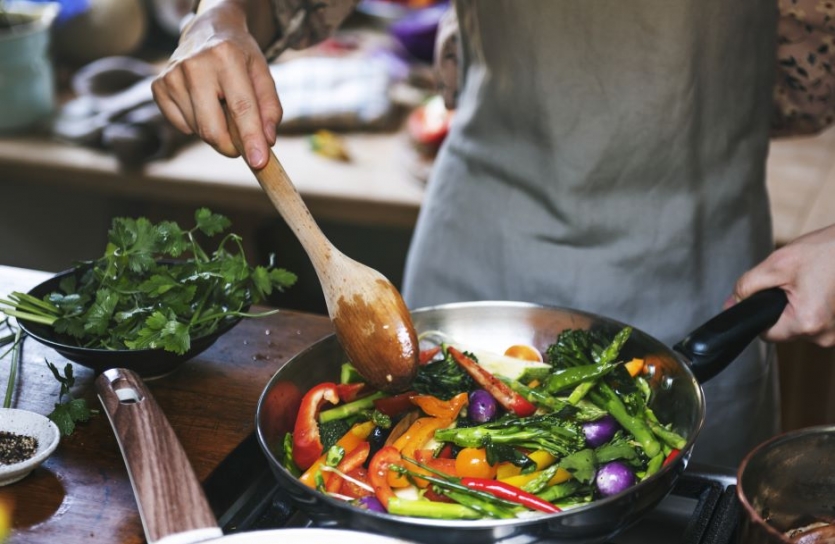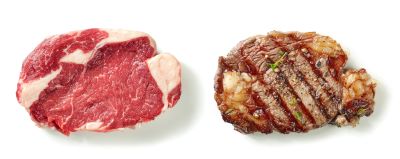
There are two sides to every vegetable—raw and cooked. You might happily crunch on a bag of fresh baby carrots, but gag at the thought of eating one boiled. And it turns out, cooking isn’t just a matter of taste. People often think of cooking as a way to enhance the flavor of food—and it is. But, as you prepare your food, you may also want to think about the effect of cooking on nutrients.
With the growing popularity of raw food diets, you’ve likely heard something along these lines: Raw vegetables are the most nutritious; when you cook veggies, you lose nutrients. The same is sometimes said of meat, eggs, and just about every other food group. It’s a plausible claim, but is it true?
The short answer is sometimes. But let’s dive into the long answer. The original question presents a simple binary: Raw vs. cooked. In reality, the situation is much more complicated. There is, after all, more than one way to cook a vegetable. And various nutrients respond differently to each cooking method.
A Quick Overview of Nutrients
Broadly speaking, you’ll find two types of nutrients in food: macronutrients and micronutrients. Macronutrients are the well-known trio of fats, carbs, and proteins. They’re the main components of your diet and supply the body with energy and building blocks.
Micronutrients, on the other hand, are needed in smaller amounts. (But don’t let this deceive you! Micronutrients are just as important to your health as macronutrients.) Micronutrients include vitamins, minerals, and phytonutrients (plant compounds). These nutrients help regulate and maintain healthy reactions within your body on a cellular level.
Most studies looking into the effect of cooking on nutrients focus on micronutrients—specifically vitamins. And for the purposes of this article, that’s largely the focus, too.
There are two types of vitamins: fat soluble (vitamins A, D, E, and K) and water soluble (vitamin C and the B vitamins). The difference is pretty straightforward. Vitamin C and the collection of B vitamins dissolve in water, whereas vitamins A, D, E, and K dissolve in fat. So what does this have to do with cooking?
Some cooking methods use water and others use fat. The solubility of a vitamin is one of the best indicators of how it will react to certain cooking methods. For instance, the quantity of vitamin C (a water soluble vitamin) in any given vegetable tends to decrease when that vegetable is boiled.
Solubility is a good starting point, but, of course, it gets more complicated. Let’s dig in.
The Effect of Cooking on Nutrients: What’s Happening on the Inside?
There’s no easy equation for choosing the best cooking method for nutrition. Not only do nutrients react differently to various types of cooking, but their reactions also vary across different types of vegetables. A boiled Brussels sprout, for example, loses some of its vitamin C. The levels of beta-carotene in chard, however, increase with cooking.
These variations are caused by the cellular structure of vegetables. Depending on where in the cell a nutrient is stored, cooking can do the following:
- Make the nutrient more readily absorbed (as the cell wall softens)
- Break down the nutrient itself
- Kill off oxidizing agents that would otherwise reduce the quantity of that nutrient
Let’s revisit that initial claim: Cooking vegetables reduces their nutritional value. Clearly, this isn’t always the case. In instances where cooking softens the tissues of plant cells, certain vitamins are released, making extraction—and detection—easier. In other words, some vegetables become more vitamin-rich when cooked.
This means there are three factors to consider when looking at the effect of cooking on nutrition: the method of cooking, the vegetable being cooked, and the specific nutrient being measured.
Let’s take a look at several common vitamins to see how they respond to various cooking methods in a variety of vegetables.
Vitamin C
For most people, vitamin C brings citrus to mind—and the bright fruits are admittedly an excellent source of vitamin C. But you’re probably not cooking your oranges and lemons. The vegetables rich in vitamin C—think broccoli, Brussels sprouts, and spinach—are another story.
Boiling is one of the most popular ways to prepare broccoli and Brussels sprouts. But if you’re trying to get your daily vitamin C, you should opt for a different cooking method—one that doesn’t use water. Because vitamin C is water-soluble, it seeps out of the vegetables and into the water. And that water goes straight down the drain. (In many cases, boiling reduces the vitamin C content of vegetables by more than 50 percent!)
Vitamin C is also heat sensitive. Expose your vegetables to heat for too long and you’ll run into the same problem as boiling. So what does this mean for you and your kitchen habits?
There’s nothing wrong with boiling your broccoli—it’ll taste delicious—but if you’re trying to optimize vitamin C intake, you should choose a low heat, water-free cooking method. Think sautéing, microwaving, or, better yet, leave it raw.
Vitamin K
To remember the role of vitamin K in the body, remember the two Bs: blood and bones. Vitamin K is a fat-soluble nutrient that helps support your body’s normal blood clotting processes and maintain healthy bones. Vitamin K is found primarily in leafy greens like spinach, chard, beet greens, and kale.
Vitamin K is less fickle than some other vitamins. Spinach, for example, retains most of its vitamin K content regardless of how you cook it. And most cooking methods will actually increase the levels of available vitamin K in chard.
If you’re trying to up your vitamin K intake, don’t give too much thought to your cooking method. Focus instead on what you’re eating your veggies with. Remember, vitamin K is fat soluble. Preparing those veggies with olive oil or another source of beneficial fats will help your body absorb the essential nutrient.
Beta-Carotene (Vitamin A)
Strictly speaking, beta-carotene is a phytonutrient (a plant compound), which the body then converts into vitamin A. This essential vitamin then helps support the immune system and optimizes healthy retinal function (hence the adage that carrots are good for the eyes).
Beta-carotene is what makes carrots orange, so it should come as no surprise that those crunchy root veggies are packed with phytonutrients. Raw carrots are an excellent source of beta-carotene, but when they’re cooked—especially boiled lightly or steamed—your body can absorb more of that important phytonutrient.
The same can be said for spinach and chard—both (slightly less) excellent sources of beta-carotene. When boiled, these leafy greens show increased levels of available beta-carotene. (This is caused, as you might have guessed, by the softening of cell walls.)
Vitamin E
Vitamin E helps support your body’s protections from threats. As a powerful antioxidant, it helps neutralize free radicals—highly reactive molecules that can be harmful to cells. Vitamin E also helps maintain your immune system. Long story short, it’s something you want to have in your body.
Root vegetables (potatoes, carrots, etc.) and leafy greens (spinach, chard, and the like) contain vitamin E. But that’s where the similarities end.
No matter how you cook root vegetables, their levels of vitamin E will always decrease. That’s kind of a bummer, because who likes to eat raw potato? Leafy greens, however, are the opposite. When leafy greens are cooked, the quantities of available vitamin E increase significantly. And by now you know why—the breakdown of the cell walls.
So if it’s vitamin E you’re after, skip the raw potatoes and go for cooked greens.
What About the Effect of Cooking on Nutrients in Meat?

Enough about vegetables, let’s get to the meat of the story. Cooking meat properly is notoriously difficult. At its best, meat is tender, flavorful, and free from bacteria. Prepared wrong and it’s, well, the opposite—bland and tough.
And when you take health and nutrition into account, cooking meat only becomes more complicated.
Although meat is rich in B vitamins, exposing it to high temperatures for too long can greatly reduce the essential nutrients’ overall availability. Some of the B vitamins are lost in the juices that drip from the meat, but if you collect and serve that juice as part of the dish, you’ll have a tasty sauce and retain valuable nutrients! That’s a win-win situation.
Unfortunately, when cooking meat, your biggest concern shouldn’t be the nutrients you’re losing, but rather the substances you are creating (and then eating). When the fats and juices from meat come in contact with cooking surfaces at high temperatures, they create smoke.
That smoke can contain harmful chemicals called heterocyclic amines (HCAs) and polycyclic aromatic hydrocarbons (PAHs), which becomes part of your food. To minimize your intake of PAHs and HCAs, avoid grilling and searing your meat. Instead opt for baking or broiling—both of which can have delicious results!
To Boil or Bake: Selecting the Best Cooking Method for Nutrition
If there’s one thing to take away from this article, it’s this: when it comes to cooking and nutrition, there isn’t an easy answer. Is raw better than cooked? Sometimes. It depends on what you’re cooking, how you’re cooking it, and the nutrient you’re measuring.
To ensure you’re getting the nutrients you need, eat a variety of vegetables prepared in a variety of ways. This approach will delight your taste buds, too.
Article source: https://askthescientists.com/food-preparation/?id=13550953&source=copiedlink
Comments
Post a Comment